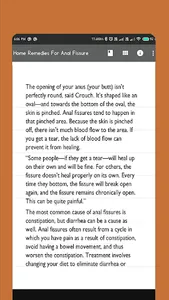Home Remedies For Anal Fissure | An anal fissure is a cut or tear occurring in the anus (the opening through which stool passes out of the body) that extends upwards into the anal canal. Fissures are a common condition of the anus and anal canal and are responsible for 6% to 15% of the visits to a colon and rectal (colorectal) surgeon. They affect men and women equally and both the young and the old. Fissures usually cause pain during bowel movements that often is severe. Anal fissure is the most common cause of rectal bleeding in infancy.
Anal fissures occur in the specialized tissue that lines the anus and anal canal, called anoderm. At a line just inside the anus (referred to as the anal verge or intersphincteric groove) the skin (dermis) of the inner buttocks changes to anoderm. Unlike skin, anoderm has no hairs, sweat glands, or sebaceous (oil) glands and contains a larger number of sensory nerves that sense light touch and pain. (The abundance of nerves explains why anal fissures are so painful.) The hairless, gland-less, extremely sensitive anoderm continues for the entire length of the anal canal until it meets the demarcating line for the rectum, called the dentate line. (The rectum is the distal 15 cm of the colon that lies just above the anal canal and just below the sigmoid colon.)
What are the signs and symptoms of anal fissures?
The primary symptom of anal fissures is pain during and following bowel movements.
Other symptoms that may occur are bleeding, itching, and a malodorous discharge.
What causes anal fissures?
Anal fissures are caused primarily by trauma, but several non-traumatic diseases are associated with anal fissures and should be suspected if fissures occur in unusual locations.
How are anal fissures diagnosed?
Anal fissures are diagnosed and evaluated by visual inspection of the anus and anal canal.
What natural home remedies help relieve pain and treat anal fissures?
Anal fissures are initially treated conservatively with home remedies and OTC products that include adding bulk to the stool, softening the stool, consuming a high fiber diet, and utilizing sitz baths.
Download the app to know more..
Anal fissures occur in the specialized tissue that lines the anus and anal canal, called anoderm. At a line just inside the anus (referred to as the anal verge or intersphincteric groove) the skin (dermis) of the inner buttocks changes to anoderm. Unlike skin, anoderm has no hairs, sweat glands, or sebaceous (oil) glands and contains a larger number of sensory nerves that sense light touch and pain. (The abundance of nerves explains why anal fissures are so painful.) The hairless, gland-less, extremely sensitive anoderm continues for the entire length of the anal canal until it meets the demarcating line for the rectum, called the dentate line. (The rectum is the distal 15 cm of the colon that lies just above the anal canal and just below the sigmoid colon.)
What are the signs and symptoms of anal fissures?
The primary symptom of anal fissures is pain during and following bowel movements.
Other symptoms that may occur are bleeding, itching, and a malodorous discharge.
What causes anal fissures?
Anal fissures are caused primarily by trauma, but several non-traumatic diseases are associated with anal fissures and should be suspected if fissures occur in unusual locations.
How are anal fissures diagnosed?
Anal fissures are diagnosed and evaluated by visual inspection of the anus and anal canal.
What natural home remedies help relieve pain and treat anal fissures?
Anal fissures are initially treated conservatively with home remedies and OTC products that include adding bulk to the stool, softening the stool, consuming a high fiber diet, and utilizing sitz baths.
Download the app to know more..
Show More

















